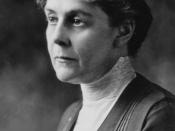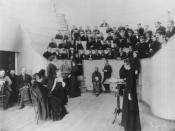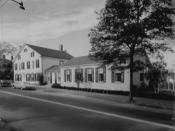Alice Hamilton was born in 1869 in Fort Wayne, India to Montgomery Hamilton and Gertrude Hamilton, one of the founding familes of the colony. She was the one of four daughters and a son and was home schooled and completed her early education at Miss Porter's School in Farmington, Connecticut.
After attending a girls' boarding school that gave little attention to science, she spent a summer being tutored in chemistry and physics before entering the University of Michigan Medical School. In 1893, she received her ÃÂdoctor of medicineÃÂ degree from the University, and then finished internships at the Minneapolis Hospital for Women and Children, and the New England Hospital for Women and Children.
Hamilton traveled to Europe to study bacteriology and pathology at universities from 1895 to 1897, however, women were not as welcome as men were in German Universities, so she was rejected in Berlin, but fouund opportunity in Frankfurt, Germany.
When she returned to the U.S., she continued her postgraduate studies at the Johns Hopkins University Medical School. In 1897, she moved to Chicago, where she became a professor of pathology at the Woman's Medical School of Northwestern University.
Soon after moving to Chicago, Hamilton became a member and resident of Hull House, the settlement house founded by social reformer Jane Addams. Living side by side with the poor residents of the community, she became very interested in the problems that the workers faced, especially occupational injuries and illnesses. The study of 'industrial medicine' (the illnesses caused by certain jobs) had become important since the Industrial Revolution of the late nineteenth century had led to new dangers in the workplace. In 1907, Hamilton began exploring existing literature and noticed that industrial medicine was not being studied much in America, and she set out to change this. She devoted her medicinal studies to finding the causes for the high rate of typhoid fever and tuberculosis in the neighboring community. In the tuberculosis study she recognized bad working conditions as one of the factors that weakened the resistance of poor immigrants to the disease.
Because of her health experience, in 1908 Hamilton was appointed by the governor of Illinois to the newly formed Occupational Diseases Commission of Illinois, the first kind of ÃÂinvestigative bodyÃÂ in the United States. For next decade she studied a wide range of issues for a variety of state and federal health committees.
In 1919, Hamilton was hired as assistant professor in a new Department of Industrial Medicine at Harvard Medical School, making her the first woman appointed to the faculty there. A New York Tribune article celebrated her appointment with the headline: "A Woman on Harvard FacultyÃÂThe Last Citadel Has FallenÃÂThe Sex Has Come Into Its Own," but Hamilton was still discriminated against as a woman and was excluded from social activities and the all-male graduation processions.
The plan was for her to be in residence six months of each year; the rest of the time was to be spent on her surveys. Because of this unusual arrangement, when she retired in 1935, she was still only an assistant professor.
Over the years, Hamilton played an important role in preventing poisonous effects of aniline dyes, carbon monoxide, mercury, tetraethyl lead, radium (in wristwatch dials among other uses), benzene, the chemicals in storage batteries, and carbon disulfide and hydrogen sulfide gases created in the manufacture of viscose rayon. She died in 1970.
She is still recognized today. In 2002, she was made an ACS National Historical Chemical Landmark in recognition of her role in the development of occupational medicine.





